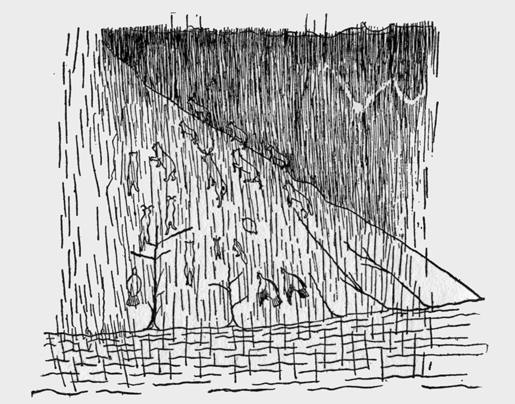O-way-way-ham-by-yoh, in the land of the Taos Indians, all of the tribe went out in the forest to gather nuts. While they were there a young girl with a cruel heart found a little baby boy. She did not tell anybody about the baby boy; and she had no way to carry him home with her, so when they returned to the village she left the little fellow in the mountains.
Ten years later a party of Taos Indians went up into those same mountains with long bows and arrows to hunt deer. While they were slipping around quietly behind the trees, they saw an old coyote with some little coyotes; and standing beside them was a little naked boy ten years old. The Indians did not dare to shoot at the coyotes for fear they might kill the little boy, so they jumped out from behind the trees and tried to catch the boy. But he was too quick for them. He could run faster than the coyotes, and they all ran into the coyote's den in the side of the mountain.
The mother coyote had found that little baby and taken him to her den. She had fed him and kept him all those years.
The Indians went back home and called a council of all of the tribe. They told them about the little boy they had seen in the mountains.
"He belongs to our tribe, we must go up into the mountains and get him," said the old chief.

He could run faster than the coyotes
So the warriors went up into the mountains. One warrior went to the mouth of the coyote's den. The other warriors made a big circle around the place where the little boy and the coyotes were, in order to try to catch him. The little boy was so quick, he ran right through the circle and ran as fast as he could toward his den-house; but the man there caught the boy in his arms and held him tight.
It was so late that the Indians had to camp in the woods that night. They made a big fire and roasted some deer meat for their supper. The little boy would not eat any cooked meat. The Indians had to feed him with raw meat just like the coyotes had fed him.
When they got back home the Indians named the little boy Deh-a, which means "fox"; because he came from the woods. They put Deh-a down into the cellar of a house for a year to tame him, and all the Indians prayed that the Great Spirit would give him magic.
Deh-a had learned all the animal languages while he lived with the coyotes. He knew all the signs of the weather – when it would rain and when it would snow. When he heard the coyotes howl, Deh-a knew there was danger from other animals; and so he became a very wise little boy.
One day Deh-a looked at the clouds growing dark all around the village. He told the Indians it was going to rain for forty days and forty nights. He begged them to pack up all the food they would need for forty days and to climb to the top of the highest mountain, so that the rain might not drown them.
Half of the Indians did not believe him and stayed at home. The other half took food and climbed up the highest mountain they could find. When they reached the top of the mountain, the rain began to fall and all kinds of animals climbed the mountain too, until the top of the mountain was all covered with Indians and animals. The turkeys were the last ones to get there. It rained so hard and so fast that water covered all of the low places. It drowned all of the people who stayed at home and washed away their houses. The water covered all of the trees, all of the hills and all of the mountains, except the one where the Indians had gone with Deh-a. It ran around the mountain top so fast that it became covered with white foam, little bubbles, you know – and the foam touched the tails of the animals that were on the lowest ring around the mountain and those animals have white tips on their tails to this very day.

All kinds of animals climbed the mountain
This chapter has been put on-line as part of the
BUILD-A-BOOK Initiative at the
Celebration of Women Writers.
Initial text entry and proof-reading of this chapter were the work of volunteer
Nathalie Servranckx.